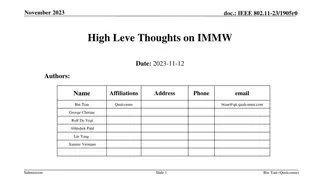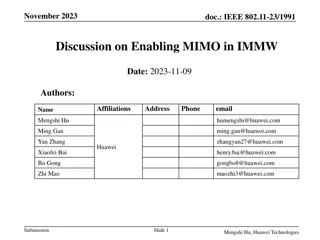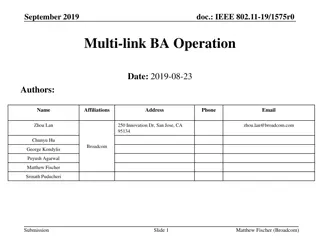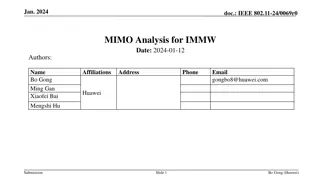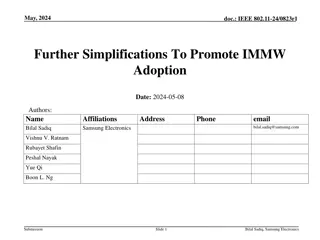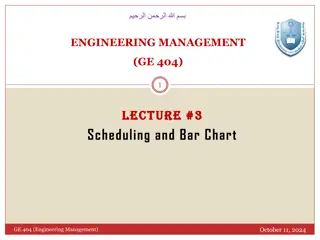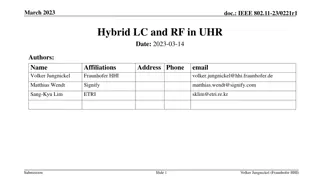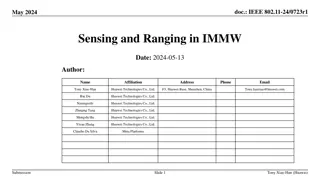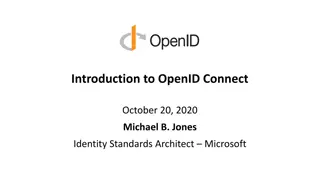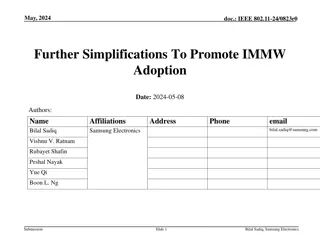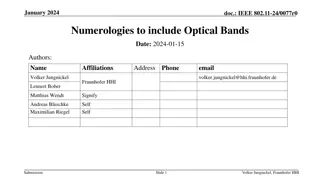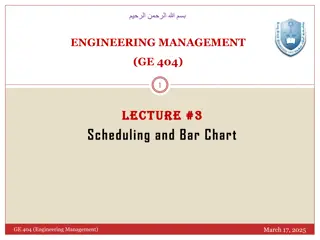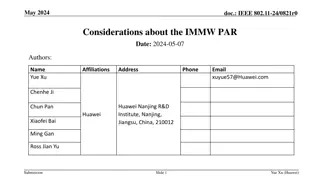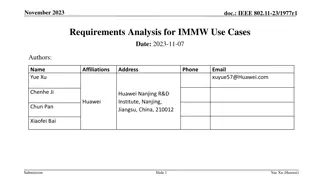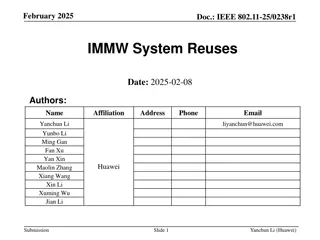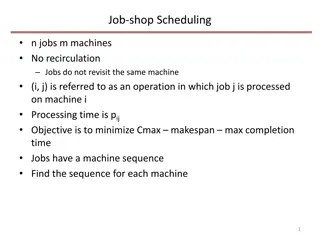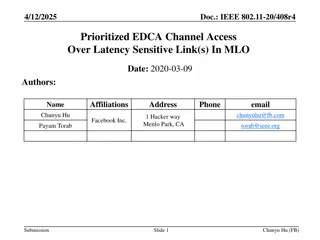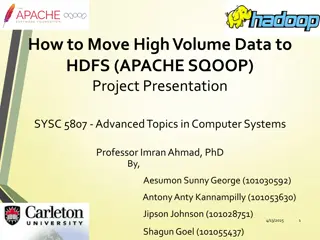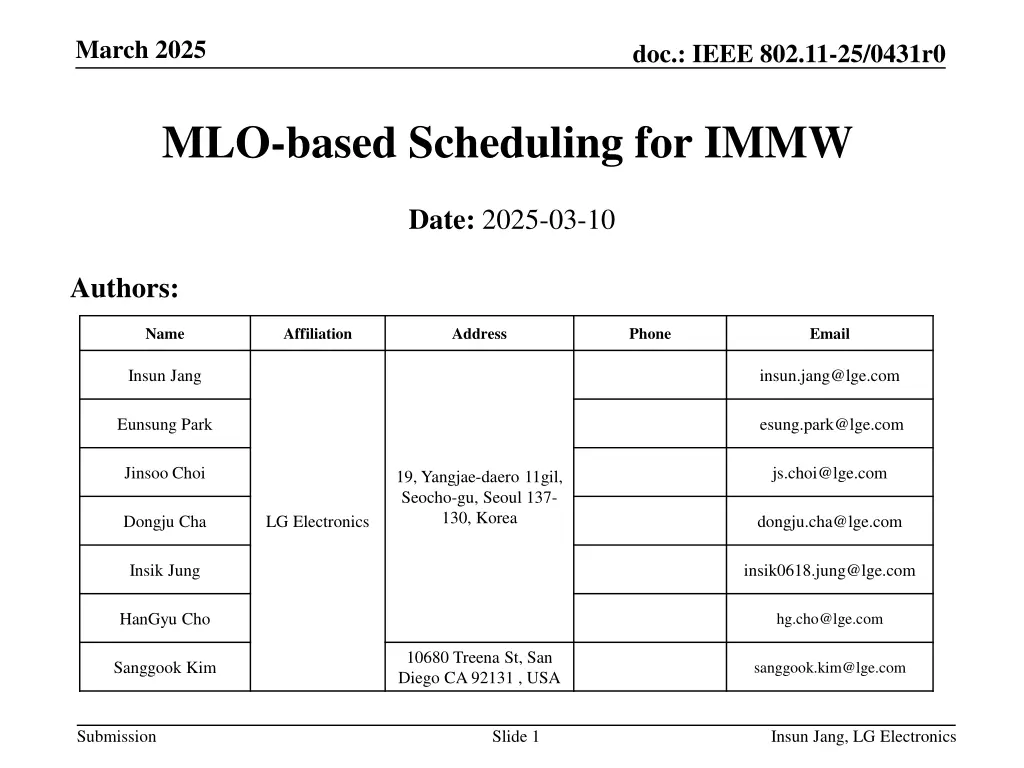
Efficient Scheduling for IEEE 802.11 Networks
Explore MLO-based scheduling for IMMW in IEEE 802.11 networks, focusing on beamforming training, multi-link operations, and scheduling approaches to manage BFT and directional TX efficiently while reducing power consumption. The discussion includes management mechanisms, beamforming training protocols, scheduling strategies, and link configurations to optimize network performance.
Download Presentation

Please find below an Image/Link to download the presentation.
The content on the website is provided AS IS for your information and personal use only. It may not be sold, licensed, or shared on other websites without obtaining consent from the author. If you encounter any issues during the download, it is possible that the publisher has removed the file from their server.
You are allowed to download the files provided on this website for personal or commercial use, subject to the condition that they are used lawfully. All files are the property of their respective owners.
The content on the website is provided AS IS for your information and personal use only. It may not be sold, licensed, or shared on other websites without obtaining consent from the author.
E N D
Presentation Transcript
March 2025 doc.: IEEE 802.11-25/0431r0 MLO-based Scheduling for IMMW Date: 2025-03-10 Authors: Name Affiliation Address Phone Email Insun Jang insun.jang@lge.com Eunsung Park esung.park@lge.com Jinsoo Choi js.choi@lge.com 19, Yangjae-daero 11gil, Seocho-gu, Seoul 137- 130, Korea Dongju Cha LG Electronics dongju.cha@lge.com Insik Jung insik0618.jung@lge.com HanGyu Cho hg.cho@lge.com 10680 Treena St, San Diego CA 92131 , USA Sanggook Kim sanggook.kim@lge.com Submission Slide 1 Insun Jang, LG Electronics
March 2025 doc.: IEEE 802.11-25/0431r0 Introduction Generally, 11bq focuses on an MLD with which at least one STA operating on a mmWave bands is affiliated As is widely known, Beamforming Training (BFT) on mmWave bands is necessary due to their characteristics (e.g., directional TX) and thereby Data is exchanged, which requires proper schedules and mechanisms to be enabled In this contribution, we share our thoughts on them for IMMW based on multi-link operation (MLO) For convenience, we call STAs (or APs) operating on mmWave bands mSTA (or mAPs) and also call STAs (or APs) operating on sub-7GHz bands sSTA (or sAPs) Submission Slide 2 Insun Jang, LG Electronics
March 2025 doc.: IEEE 802.11-25/0431r0 Recap: Multi-link Operation in 11be [1] Basically, Multi-link Operation provides significantly efficient operations in terms of discovery, association, authentication . Non-AP MLD can find the existence of mAP and its basic info (through RNR IE, Basic ML IE) Non-AP MLD can obtain the complete profile of mAP Non-AP MLD can setup links including the link between mSTA and mAP (on mmWave link) Non-AP MLD can disable/enable and delete/add the mmWave link through Reconfiguration ML IE Note: Some procedures are omitted (e.g., authentication) Submission Slide 3 Insun Jang, LG Electronics
March 2025 doc.: IEEE 802.11-25/0431r0 Recap: MLO for IMMW [1] A lot of management mechanisms based on MLO were well- defined in 11be Multi-link-assisted- TWT, TIM, Critical Update, TID-to-link mapping, Reconfiguration, . Thanks to the efforts, necessary mechanisms (e.g., beamforming training) in mmWave bands can designed based on MLO Submission Slide 4 Insun Jang, LG Electronics
March 2025 doc.: IEEE 802.11-25/0431r0 Scheduling-based Approach Generally, during (determined) Beacon Intervals to be repeated, beamforming training and data exchanges are performed according to requirements of each access period [2] Per-beacon interval, each access periods can be scheduled and adjusted in several frames such as DMG Beacon (e.g., using (EDMG) Extended Schedule IE), SPR frame, Grant frame , and pseudo-static SP may be configured We think that the schedule-based approach still can work in IMMW to manage BFT and directional TX properly (e.g., even for latency traffic) and reduce power consumption (e.g., [8]) Therefore, we need to discuss how to configure such schedules with the aid of sub- 7GHz APs/links Submission Slide 5 Insun Jang, LG Electronics
March 2025 doc.: IEEE 802.11-25/0431r0 Potential Directions in IMMW Assume to start with no Beacon on mmWave bands to reduce management overhead and power consumption in mmWave bands Basically, no need to announce most of ((semi)-static) capabilities and operating parameters, which can be identified/negotiated during multi-link discovery/setup If it is updated, it would be notified (e.g., by ML critical update) Schedules for BFT and (data) frame exchanges can be announced on sAP(s) or negotiated between sAP and associated sSTA Submission Slide 6 Insun Jang, LG Electronics
March 2025 doc.: IEEE 802.11-25/0431r0 Several Issues on IMMW Scheduling sAP would indicate the information of the schedule period Time Synchronization Non-AP MLD needs to understand schedule start time in reference to TSF of mAP through the timing information (e.g., gap, start time/duration, ) However, TSF may not be signaled on mmWave bands Instead, we already have TSF offset (from TSF of sAP) that would be used to identify mAP s TSF, while mAP s TSF might be considered as the same as one of sAPs or an independent one Submission Slide 7 Insun Jang, LG Electronics
March 2025 doc.: IEEE 802.11-25/0431r0 Several Issues on IMMW Scheduling (Cont d) Beamforming Training We can have dynamic BFT schedule(s) between when sAP/sSTA intends to initiate the BFT E.g., through Request/Response frame exchanges or an announced frame by assigning BFT type (e.g., TXSS, RXSS) and its relevant BFT Parameters Periodicity We can have periodic schedules to enable periodic low latency traffic (e.g., based on SCS agreements) and (semi-) static BFT (see next slide) Slide 8 Submission Insun Jang, LG Electronics
March 2025 doc.: IEEE 802.11-25/0431r0 Discussion on Periodic Schedules In terms of periodic schedule based on MLO, TWT framework can be used as a powerful candidate of scheduling mechanism TWT already had MLO function from 11be (Semi-) Static BFT It would be similar to broadcast I-TXSS, which may be ON and OFF If always on, could consider TBTT and Beacon Interval on mAP Clearly, the frame should be light if present It can be useful to reduce I-TXSS overhead of mAP, but rather it may lead to management overhead on Sub-7GHz band (Beacon) and mmWave band (BF frame), for which we need to discuss about necessity and balance Submission Slide 9 Insun Jang, LG Electronics
March 2025 doc.: IEEE 802.11-25/0431r0 Conclusion In this contribution, we provided some considerations on IMMW using Multi-link Operation, especially in terms of schedule Assume no Beacon on mmWave while schedules for BFT and (data) frame exchanges can be announced on sAP(s) or negotiated between sAP and associated sSTA We discussed Several issues on IMMW Scheduling Time Synchronization Dynamic BFT Periodicity Especially, we discussed about Periodic Schedules for periodic LLT and (Semi-) Static BFT Submission Slide 10 Insun Jang, LG Electronics
March 2025 doc.: IEEE 802.11-25/0431r0 Straw Poll 1 Do you support the following text in TGbq? TGbq defines a mechanism where a STA, that is affiliated with an MLD and operating in a Sub-7GHz band, indicates period(s) for exchanging frames on a mmWave band Submission Slide 11 Insun Jang, LG Electronics
March 2025 doc.: IEEE 802.11-25/0431r0 Straw Poll 2 Do you support the following text in TGbq? TGbq defines a mechanism where a STA, that is affiliated with an MLD and operating in a Sub-7GHz band, indicates a dedicated period to its associated STA affiliated with another MLD for exchanging frames (e.g., beamforming training) on a link in a mmWave band Frame exchange is performed between two other STAs affiliated with the MLD and that another MLD, respectively and operating the links in the mmWave band Submission Slide 12 Insun Jang, LG Electronics
March 2025 doc.: IEEE 802.11-25/0431r0 Straw Poll 3 Do you support the following text in TGbq? A TSF of an AP affiliated with an AP MLD and operating on mmWave is derived from a TSF of another AP affiliated with the same AP MLD as the AP operating on Sub-7GHz band The TSF will be derived from TSF offset and is not announced by the AP Submission Slide 13 Insun Jang, LG Electronics
March 2025 doc.: IEEE 802.11-25/0431r0 Straw Poll 4 Do you support the following text in TGbq? 11bq reuses or enhances TWT mechanisms for mmWave bands with the aid of Sub-7GHz bands NOTE: Any TWT Setup/Update/Tear-down/Announcement mechanisms are not performed on mmWave bands Submission Slide 14 Insun Jang, LG Electronics
March 2025 doc.: IEEE 802.11-25/0431r0 References [1] 24/459, Multi-link Operation for IMMW [2] IEEE P802.11-REVme [3] 24/1312, Draft P802.11bq PAR [4] 24/549, IMMW Draft Proposed CSD [5] 11-23/1905, High Level Thoughts on IMMW [6] 11-23/1819, Integrated mmWave Design Considerations [7] 11-23/1968, Discussion on general direction of integrated mmWave [8] 11-25/433, Channel Access for IMMW /D7.0 Submission Slide 15 Insun Jang, LG Electronics

